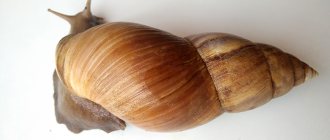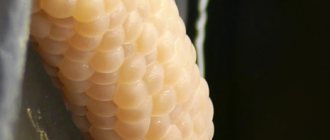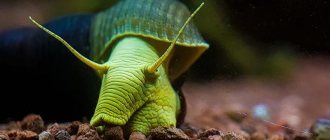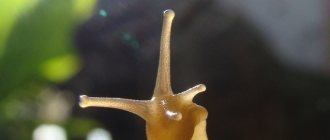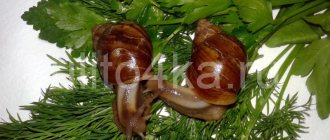Every owner of any pet knows that the healthy appearance and well-being of a pet depends precisely on the conditions of keeping and proper care. And if it is a dog or cat, then you can contact a veterinarian. But what should you do if your favorite snail begins to have problems - it doesn’t eat well, the shell turns white, or the snail’s shell peels off? Naturally, an ordinary veterinarian will not help you. Therefore, owners of such exotic animals need to treat their pet themselves. In this article we will tell you why a snail's shell is peeling and how it can be corrected.
Shell delamination in a snail is a fairly common problem that occurs due to improper maintenance or is a genetic disorder. And if the issue of maintenance can be resolved by eliminating all unfavorable factors, then the pet’s genetics cannot be corrected.
How to treat the Achatina snail?
Before answering this question, it is important to consider the list of causes of dangerous diseases in domestic aquarium snails.
Note to beginning breeders:
- Gastropods are inhabitants of southern countries with a humid and hot climate. If comfortable conditions are not created in the holding container, the pet may become ill from hypothermia or lack of moisture. Improper conditions may be indicated by the fact that the snail burrows into the ground often and for a long time. To prevent Achatina snail disease, the temperature in the aquarium should be within 24-28 degrees, and the humidity should be 95-99%, depending on the type of African gastropod.
- An uncomfortable, cramped home with rough substrate can lead to poor health and hibernation. Breeders often use regular soil, but water causes it to swell and turn into mud. The aquarium and the pets themselves look unpresentable and they need to be bathed often. In addition, midges and various insects quickly appear in the soil, dangerous to the life of delicate pets. Experienced terrarists recommend using a fine coconut substrate. It is inexpensive, has a pleasant smell, is easy to wash and is soft to the touch; capricious mollusks really like it.
- Lack of balanced nutrition is one of the main factors in the occurrence of diseases in Achatina snails. The diet should always include fresh vegetables and fruits, protein supplements from meat and cereals, calcium-containing powders from eggshells and ready-made concentrates. A drinking bowl with clean water is available and in constant access.
- It is not advisable to add other exotic pets to gastropods. Mollusks react negatively to large creatures such as lizards, snakes and scary centipedes.
Diseases carried by snails may be associated with fungal diseases and intestinal infections. This infection reaches shellfish through food. Predatory gastropods are not averse to feasting on a concentrate of their dried sea creatures, which transmit dangerous fungi and intestinal viruses to snails.
Reproduction
Sex differences
It is difficult to identify snails by their appearance.
The reproductive organ is located on the right side under the shell. Sex can be determined during mating. The snails seem to stick to each other. The female is always on the bottom.
Snails reach sexual maturity at about a year or a little later.
For breeding you will have to purchase four to five individuals. Then there is guaranteed to be a male and a female among them.
Getting offspring
Breeding of ampularia occurs by laying eggs. This is done by the female ampularia out of the water. In nature, it uses stones, stems, and tree branches for masonry. The exception is Marisa comuarietis. The snail lays eggs at the bottom of the pond.
In captivity, in the evening the female crawls out onto the glass that covers the aquarium. Less often on the walls. In any case, you should take care of at least ten centimeters of free space. You can drain some of the water.
Important! In order to start the reproduction mechanism, two conditions must be met: abundant food and high water temperature (about 30 degrees).
The ampoule lays eggs one at a time, gluing them to the glass. They emerge along the genital fold located on the leg of the mollusk. The snail moves them and compacts them slightly. It turns out to be a kind of bunch the size of a little finger.
Do I need to create a special place for masonry ? There is no need for this. The snail will make the decision itself. An important point: ampularia often lays eggs under a lamp. It's warmer there. The masonry may dry out and die. It must be carefully cut and placed on any floating surface (for example, a piece of foam).
In the first minutes, the caviar is soft to the touch and pinkish. The shell then hardens when exposed to air. Later the color changes. The bunch turns bright orange or dark green, sometimes white. Shortly before the offspring emerge, it gets dark.
Attention: What to do with ampoule caviar ? You can ignore it if you are not worried about small snails getting into the general aquarium. They will hatch without human intervention.
Babies are usually born in fourteen days. But they may delay up to a month. This depends on the ambient temperature.
Two dangers immediately await them.
- All the inhabitants of the aquarium are not averse to eating young mollusks. Their shell is soft.
- Having come off the glass, the ampularia fall into the ground. Not everyone can get out of it.
The problem can be solved by placing a fine mesh net under the eggs. Small snails are placed in a glass container.
They are fed softened dry food and plants (hornwort, Java moss).
Reproduction usually occurs in the warm season. Less often, snails give birth in winter.
Required: It is necessary to control the population. In a short time, mollusks can fill the entire space of the aquarium. Excess masonry must be removed.
Signs of disease in a pet gastropod
Responsible breeders examine their dogs daily and monitor their physical and emotional condition. At the first signs of a disease, it is necessary to urgently take measures to prevent the torment and death of delicate, defenseless mollusks.
If Achatina was in the wind or exposed to direct rays of the sun, then it may become hypothermic or overheated.
In both cases, a nice bath at room temperature or a warm shower will help her.
Read more about sink problems
Losing a shell is a real accident for an adult. This can happen as a result of infection or exposure to toxic substances. A mature pet will not survive without a shell, but young animals have a chance with good nutrition and careful care to again grow a beautiful “house”.
A change in the appearance of a mollusk shell is a sure sign of a dangerous disease. If the shell is deformed, lumps and peeling appear on it, Achatina gnaws it itself, because the shell has become fragile and layered, which means that urgent measures must be taken.
First, it is important to find out why the snail has problems with its shell?
There can be many reasons:
- Achatina parasites and fungal infections caused by them;
- poor-quality substrate in the container, its contamination due to high humidity;
- lack of calcium, or the inability to absorb it due to the lack of vitamin A and D in the diet;
- damage to the shell due to careless handling of the shellfish and failure to comply with basic safety precautions.
How to treat Achatina shell at home? First of all, it is necessary to isolate the sick individual from the native herd and clean the terrarium using gentle disinfection (do not use toxic chemicals!).
Next, completely review her diet. Perhaps low-quality fungus-contaminated feed led to such unpleasant consequences. It is important to immediately switch the patient to fresh vegetables and fruits, replace ready-made mineral supplements and food with natural cereals, ground eggshells and crushed chalk.
On a note! If you do not rid Achatina of parasites in time, the unfortunate pet may develop bumps, fungal rashes, and it may lose orientation and attack its neighbors in the terrarium.
Along with changing the diet, urgently cleanse Achatina’s body of fungal infection. As a result of infection, its delicate skin can secrete abundant white foam and become overgrown with mold. In this case, it is important to bathe the snail under running water or in a warm chamomile infusion and treat its body with a special pesticide aerosol for reptiles. The sink can be cleaned with disinfectant powder, treated with iodine and rubbed with an effective propolis-based ointment.
Diseases
usually causes incorrect content.
- Problems with the sink due to lack of calcium.
What to do? Provide quality care.
Why does the ampularia's shell collapse ? She doesn't have enough calcium. You can help by adding natural chalk, a shell or an eggshell to the water. Be sure to chop! It’s a good idea to put a sepia (cuttlefish skeleton) in the aquarium. It contains a lot of proteins. It is easy for snails to scrape it off.
- Ticks. Symptoms of the disease: depressions on the shells.
What to do? The following procedure will help. Remove the snail from the water and wipe the shell with a soft cotton cloth. Soak a cotton swab with a solution containing formaldehyde (for example, anti-steam) and wipe the sink.
If signs of the disease are found on one ampullary, all individuals must be subjected to preventive treatment.
- Other parasites can also live on snails. Sometimes a white coating, similar to fluff, appears on the shells.
Place your pet for 15 minutes (no more!) in a salt solution: 10 g. per liter of water.
- Coma. Happens due to poor maintenance in the aquarium. The animal lacks oxygen. Symptoms: the snail is alive, but does not crawl out of its shell. Place the ampularia in a glass jar with water.
Loss of shell or falling out of it
The reasons for shell loss are varied:
- genetic disposition and influence of carcinogenic substances;
- bacteria and infections that undermine the health of young mollusks, destroy mantle tissue, and disrupt digestion;
- shell fungus.
In this case, 96-98% of Achatina die. But the younger the individual, the greater the chance that it will survive by growing a new shell.
To avoid losing shells, breeders are advised to closely monitor the diet and contents of the plate, add vitamins and fertilizer containing calcium such as sepia and gammarus.
Problems with the shell
Among shell problems, the most common causes are:
- poor quality water;
- swampy, dirty ulitharium;
- oxidized substrate - peat or soil;
- insufficient or excessive calcium supplements or poor-quality calcium source;
- a fungus that leads to a change in the shape of the shell and tissues, rapid growth of the shell, and muscle atrophy.
All the problems regarding the shell are obvious. It becomes fragile and may begin to peel, flake, and become covered with bumps.
Rehabilitation consists of creating a diet that includes foods containing calcium. These include sepia, chalk, shell, slaked aged lime, gammarus, corals. You can also give calcium porridge, which includes a mixture of powders from the listed products. “Pills” made from calcium gluconate, fried sunflower seeds, shells with the addition of raw protein are also suitable.
In addition, breeders recommend using such drugs as:
- iodine. It is smeared on a dry sink in problem areas for half an hour, and then washed off with water. The procedure is carried out for three days, once a day, and then once a week until the defects completely disappear;
- propolis ointment, which should be applied once every 4-5 days to the shell;
- mycoseptin. Apply for an hour and then wash off. Used in a three-day course twice a day.
Under no circumstances should the listed products come into contact with the body of the mollusk.
Household injuries shells
Damage to the shell in this case usually occurs due to careless handling of the animal. This is possible if you press too hard on a mollusk shell or accidentally step on a fugitive who has escaped from the terrarium. In addition, Achatina itself can be damaged by falling from slippery walls onto a hard substrate.
If the shell is damaged, it can be repaired using dry epoxy glue. In this case, the pet will need to be isolated from its relatives, if any, while the material dries. In addition, you should avoid getting glue on the body. The sink itself must be washed and dried before the therapeutic procedure.
Read more about treating a cracked shell and how to repair an Achatina shell in our article.
Overheating and hypothermia
Exposure to temperatures that are too low or too high can negatively impact your snail's health. Overheating is possible if the terrarium is located near heating devices and is under direct UV radiation. Temperatures below 19 degrees and frequent drafts are no less dangerous. Hypothermia is fraught with inhibited development up to its complete stop and suspended animation, and overheating leads immediately to death.
Signs of temperature exposure may include lethargy and apathy of the animal, refusal to eat. In case of overheating, you need to place the snail under a stream of cool water, and in case of frostbite, wipe it with a warm soft cloth.
Damage by flies, bugs and bedbugs
Parasites include flies, humpbacks, springtails, bugs, as well as bedbugs, fungi and mold.
The reasons for their occurrence are:
- contaminated substrate that was poorly processed or forgotten to do so;
- contacts with infected individuals;
- rotten and unharvested food.
The snail may become lethargic, lose its appetite, and mucus production will increase. In this case, special pesticide aerosols that can destroy ticks and bugs will help.
However, this is only the first stage. Secondly, you will need to get rid of the old soil, wash the ulitaria, boil it, treat the new substrate and wash all the snails, cleaning the shells.
Is it beneficial or harmful to keep apple snails in an aquarium?
Ampoules are an excellent food for clown loaches, marbled loaches, cubeta loaches and acanthophthalmus. They are snail eaters - gourmets. By feeding on snails, they grow quickly and feel better. To remove all the snails from any aquarium, one small fight is enough.
Benefits of aquarium snails
Snails are natural orderlies: they destroy food residues, dead fish, fish excrement, rotten parts of plants, film on the surface of the water, and plaque on the walls of the aquarium.
Snails play an important role in maintaining biological balance in an artificial reservoir, and the behavior of some snails serves as an indicator of the cleanliness of the soil or water, which helps the aquarist to notice and solve the problem of pollution in time.
Snails are beautiful in their own way and can serve as an element of aquarium decoration.
Infection with helminths and worms
Dangerous diseases of snails can be associated with infection of internal organs. Unfortunately, worms also appear in these slow, defenseless creatures. Mollusks can become infected from humans and other pets, so it is not advisable to often handle Achatina.
Worms can get to Achatina from oysters and other snails living in natural conditions, from owners and pets like cats and dogs.
A snail infected with helminths becomes lethargic and loses weight. In addition, some worms are visually noticeable on the pet's body. If the owner does not take any measures, the animal dies in 9 out of 10 possible cases.
The following are used as therapy:
- cucumbers and carrots;
- pumpkin seeds, which are rubbed together with the peel;
- chamomile and other herbal infusions in strictly dosed form;
- aloe pulp, which is given both as food and Achatina is bathed in it;
- brewer's yeast, which is infused for 2-3 days before use.
But most medications for helminths for shellfish are toxic. Therefore, they should be used with extreme caution.
Ideally, during treatment, for two weeks, the temperature in the ulitaria will be 27-28 degrees Celsius. The affected individual moves away from its brethren to a new home with clean soil.
The most effective in treating parasites are mixtures of several herbs, ground into a fine powder. They can be added to porridge made from pureed seeds that have been soaked in beer for a day.
An excellent remedy for helminths is crushed raw pumpkin seeds and aloe leaves. If such an unpleasant disease is detected, it is important to give your pet daily chamomile baths and introduce effective products into the diet to kill parasites.
Chemical burn and poisoning
When burned or poisoned by chemicals, 96% of individuals die. Contact with harmful substances is possible in the following cases:
- the food that came into the bowl was treated with pesticides;
- the owner did not wash the ulitharium well after cleaning it;
- salt got into the house, which is harmful to the mollusk.
If the breeder notices that the shell is foaming and bubbling, and the body is covered with white mucus, you can try to save the pet. To do this, Achatina should be washed under water. If this does not help, then death is inevitable. In this case, the best option is to put the animal in the cold. There it will die in its sleep, without suffering.
You can avoid chemical exposure by thoroughly washing the soil and rinsing the aquarium. You should not resort to the use of chemicals to clean the house, and the snail itself should not be released outside of it unnecessarily.
This is interesting
- Within one species there are many variations of body and shell colors. Therefore, it is impossible to determine the type of snail based on color.
- An albino snail is not white, but yellow.
- Pomacea are completely deaf.
- Under natural conditions, the cover of the mouth of the shell helps to survive difficult climatic conditions. In dry or cold times, the snail seals it tightly, sinks into the ground and falls asleep. Domestic snails, when properly kept, do not hibernate.
- European Union countries have banned the import and distribution of ampoule on their territory. The high fertility of snails harms the aquatic ecosystem. Voracious mollusks cause damage to rice plantations.
Tumors
Neoplasms can be spontaneous, malignant or benign. The reasons why they arise include:
- poor quality soil;
- unkempt utilitarian or poor materials from which it is made;
- contaminated feed;
- infections;
- perforators of shells such as sponges, algae.
If the tumor is benign, the mollusk may behave as usual. But if its condition gets worse day by day, and the neoplasm causes discomfort, Achatina refuses to eat and becomes apathetic, then the best option is to freeze it. This will prevent your pet from suffering.
In other cases, you can try to cure the animal with medications such as ointments with propolis, mycoseptin and iodine. You can invite the snail to take chamomile infusion inside.
Simple and systematic, daily actions will help you avoid all of the above. These include:
- caring for the ulitaria, cleaning it and timely replacing the soil;
- maintaining a balance of temperature and humidity;
- selection of nutrition, a well-structured diet and a ban on salty, smoked, sweet foods;
- processing of raw products such as fruits and vegetables, monitoring the expiration date of food.
A caring breeder who adheres to the listed rules will be able to grow an Achatina that can please him for many years.
Description
In nature, yellow Ampoules are most often found, although the colors can be very different, for example, black, brown or even white. Blue snails are in great demand among aquarium owners, although caring for small pets is the same and does not depend on their shade. When choosing Ampularia, you need to understand that this type of snail is larger than its relatives. In stores you can buy a small snail with a diameter of no more than 2.5 cm, but in the end it grows to 8 or even 10 cm.
The color of snails may vary
In aquarium conditions, snails can grow to incredible sizes for their species. Of course, this is possible with proper care and proper nutrition. As a result, Ampularia are quite capable of competing in size with such giants as, for example, the Maryse snail.
Note! The average lifespan in aquarium conditions is 2 years. In their natural environment, snails live shorter lives.
